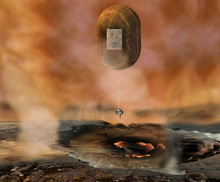Venus In Situ Explorer
This article needs additional citations for verification. (February 2008) |

The Venus In Situ Explorer (VISE) is a mission proposed since 2003 by the Planetary Science Decadal Survey as a space probe designed to answer fundamental scientific questions by landing and performing experiments on Venus.[1] It is a candidate for NASA's New Frontiers program to be launched in 2024. The Principal Investigators are currently refining and promoting the mission concept.[2]
Overview and capabilities
While on the surface, the Venus In Situ Explorer will acquire and characterize a core sample of the surface to study pristine rock samples not weathered by the very harsh surface conditions of the planet. Also, the VISE will determine the composition and mineralogy of the surface.
Various exploration concepts
Several variant mission concepts for a Venus in situ mission have also been proposed, including both surface and atmospheric exploration:
- Other surface exploration concepts
- Aerobot concepts
- Venus airplane concepts
References
- ^ Venus Exploration Analysis Group (VEXAG)
- ^ Smith, B; Venkatapathy, E.; Wercinski, P.; Yount, B. (2013), "Venus In Situ Explorer Mission design using a mechanically deployed aerodynamic decelerator", 2013 IEEE Aerospace ConferenceZ, IEEE Explore, retrieved January 11, 2014
External links
- NASA Atmospheric Flight on Venus Landis, Geoffrey A., Colozza, Anthony, and LaMarre, Christopher M., International Astronautical Federation Congress 2002, paper IAC-02-Q.4.2.03, AIAA-2002-0819, AIAA0, No. 5



